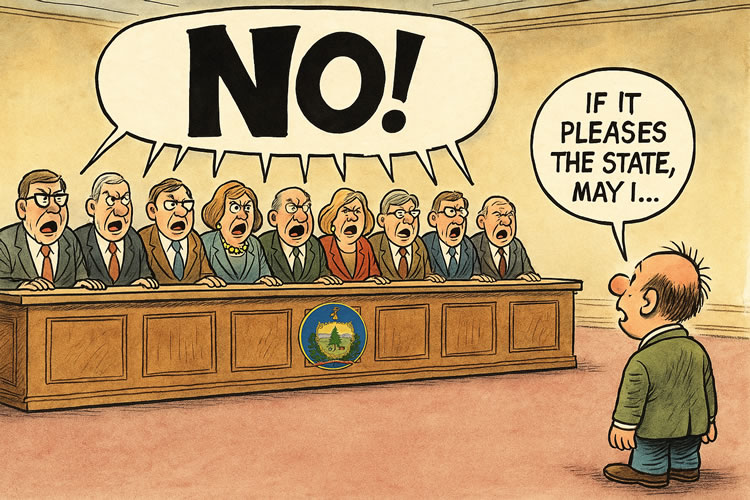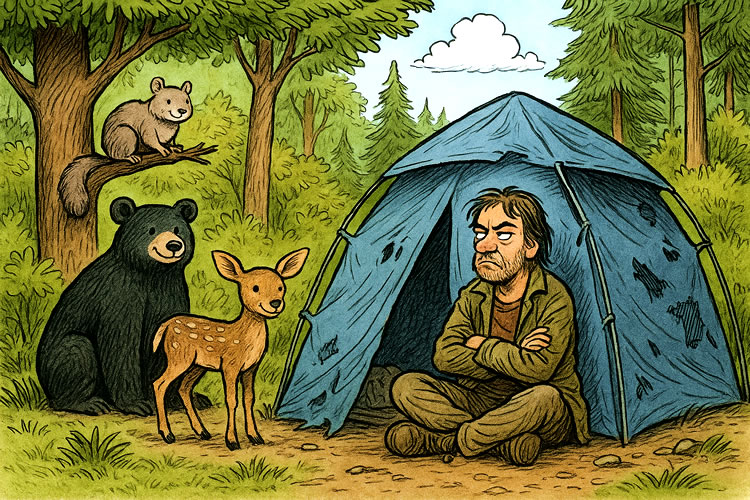Vermont’s environmental establishment has spent the past decade warning that the state’s forests are under siege from “fragmentation” and “parcelization“. The Vermont Natural Resources Council (VNRC), The Nature Conservancy (TNC), and Vermont Conservation Voters (VCV) have built entire campaigns around the idea that private forestland must be “protected” through tighter state oversight.
The refrain sounds familiar: “our forests,” “shared natural heritage,” “keeping forests intact.” Those words appear in every policy brief and hearing room handout. But while that language feels civic-minded, it carries a quiet redefinition of ownership. When Vermont’s forests become “ours,” the right to decide what happens on them moves from the people who hold the deeds to the institutions that hold the microphones.
The rhetoric of shared ownership
VNRC’s website declares, “Vermont is the third-most forested state of the lower 48.” The organization immediately follows that with a warning that “fragmentation” is “gaining momentum” and must be addressed through new regulation. The Nature Conservancy’s Biodiversity Protection Fund map paints broad swaths of already-wooded mountains as “priority focal areas.” Vermont Conservation Voters echoes both, calling for “permanent conservation measures” and stricter Act 250 review to “protect our shared forests.”
In unison, these groups describe Vermont’s landscape as if it were on the brink of collapse. Yet none of them present data showing an ecological crisis—only that more people might someday build something within view of a tree line.
The data they don’t quote
The federal government already measures Vermont’s forests through the USDA Forest Service’s Forest Inventory and Analysis program. The 2020 report is matter-of-fact:
- Vermont is 74–76 percent forested, or roughly 4.52 million acres.
- 78.8 percent of that land is privately owned; only 10 percent is federal, and another 10 percent state or local.
- Annual net loss: about 12,600 acres, partly offset by 3,400 acres reverting to forest each year.
- Total live-tree volume increased, from 10.4 to 11 billion cubic feet between 2015 and 2020.
- Average annual disturbance from fire: zero acres. Weather damage: about 700 acres statewide.
Those are not the numbers of a collapsing ecosystem. They are the numbers of a stable, functioning, privately managed landscape.
Between 2007 and 2013, Vermont lost roughly 75,000 acres of forest—less than two percent. Put another way: if you had $4.5 million in the bank and bought a $75,000 truck, would you be “on the verge of bankruptcy”? That’s the same ratio. Yet that minimal change has been presented in hearings and reports as evidence of “accelerating fragmentation.”
At the current rate of loss, Vermont’s forests would take 360 years to disappear — assuming no Sweet Meteor of Death intervenes first.
From study to statute
The 2015 Forest Fragmentation Report, written under the Shumlin administration with input from VNRC and TNC, laid the groundwork. It recommended mapping “interior forest blocks” and incorporating them into Act 250. Over the next several sessions, those concepts migrated from advisory white papers to rulemaking drafts and finally to statute. In 2023, lawmakers added Criterion 8(C) to Act 250, requiring developers to prove that projects will not “fragment forest blocks or wildlife corridors.”
The practical effect is that the nonprofit maps—colored polygons stretching across the Green Mountains—now function as quasi-regulatory overlays. A permit applicant who ignores them risks denial. Vermont’s land-use review process has quietly absorbed the advocacy playbook as policy.

Sources: Nature Conservancy VT Biodiversity Fund, Bing Maps (2025).
🍁 Make a One-Time Contribution — Stand Up for Accountability in Vermont 🍁
Control without ownership
This is the essence of regulatory collectivism: control without ownership, and ownership without control. No one confiscates the land, but the decisions about its use migrate to bureaucracies and boards. The landowner still pays the property tax, the storm-water upgrades, and the compliance costs tied to the Clean Water Act or the three-acre rule. When the bill comes due, it’s your land; when policy is written, it’s our forest.
Administrative creep by design
Each campaign begins as a suggestion—voluntary guidelines, best practices, or “shared goals.” Then the language hardens: “priority areas,” “critical habitat,” “necessary connectivity.” Eventually the phrasing becomes regulation. This step-by-step progression is administrative creep: small increments of control justified by rhetoric of consensus. By the time the rule is on paper, the argument that created it has already been forgotten.
The federal view versus the activist view
The Forest Service’s 2020 assessment doesn’t sound alarmist. It describes a healthy forest economy where private management has succeeded in sustaining canopy, wildlife, and water quality. The agency notes that Vermont’s wood volume is increasing, not shrinking. In short, Washington’s data—hardly written by “hard-right wingers”—suggest that private stewardship works.
Contrast that with the activist position. VNRC, TNC, and VCV treat the same landscape as an emergency demanding perpetual intervention. They occupy the seats at legislative tables, submit the talking points, and shape the permitting standards. The average citizen lives with the consequences: higher compliance costs, constrained property rights, and housing shortages in the name of “connectivity.”
A crisis of politics, not ecology
Vermont’s forests are not dying; they are being managed into bureaucracy. The danger is not fragmentation of trees but fragmentation of responsibility—where the authority to decide is collective, but the obligation to pay is individual. The landscape that once symbolized independence is now the backdrop for rulemaking by committee.
If the state truly believes in sustainability, it might start by sustaining trust in its citizens—the same private owners whose stewardship has kept Vermont green long before the maps were drawn.
Dave Soulia | FYIVT
You can find FYIVT on YouTube | X(Twitter) | Facebook | Parler (@fyivt) | Gab | Instagram
#fyivt #VermontForests #Act250 #RegulatoryCollectivism
Support Us for as Little as $5 – Get In The Fight!!
Make a Big Impact with $25/month—Become a Premium Supporter!
Join the Top Tier of Supporters with $50/month—Become a SUPER Supporter!









Leave a Reply